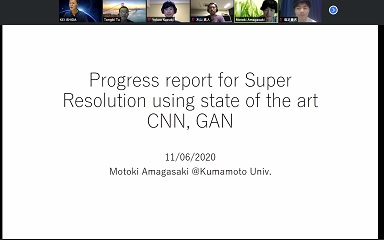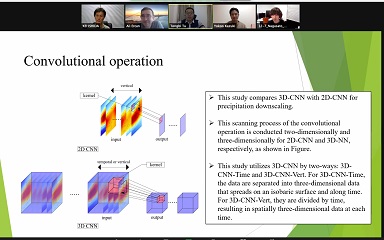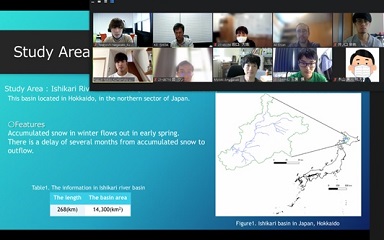- HOME
- RESEARCH
- Research Units
- Deep Learning for Hydrology
RESEARCH
Deep Learning for Hydrology
This research unit consists of five members. Three of the members have expertise in hydrology. The other two are experts in computer science. The objectives of this research unit are to apply deep machine learning techniques to hydrological issues, and meanwhile develop new deep learning techniques with hydrological data. Deep learning is nowadays a very popular approach in many fields. However, deep learning has hardly been applied to hydrological issues so far. There are many things that can be improved by deep learning techniques. In addition, it may be required to develop new deep learning techniques in order to solve hydrological issues. Collaborative work between hydrologists and computer scientists has a large potential to solve many kinds of hydrological issues.
Unit members
-
 Unit coordinatorKei ISHIDA
Unit coordinatorKei ISHIDAAssociate Professor
Center for Water Cycle, Marine Environment, and Disaster Management, Kumamoto UniversityJapan -
 Motoki AMAGASAKI
Motoki AMAGASAKIProfessor
Faculty of Advanced Science and Technology, Kumamoto UniversityJapan -
 Masato KIYAMA
Masato KIYAMAAssistant Professor
Faculty of Advanced Science and Technology, Kumamoto UniversityJapan -
 Ali ERCAN
Ali ERCANAssociate Professor
Civil Engineering Department, Middle East Technical UniversityTurkey -
 Tongbi TU
Tongbi TUAssociate Professor
School of Civil Engineering, Sun Yat-Sen UniversityChina
Achievements
Publications
| ~ Added on Mar. 29, 2022~ |
Tomoki Izumi; Motoki Amagasaki; Kei Ishida; Masato Kiyama, "Super-resolution of sea surface temperature with convolutional neural network- and generative adversarial network-based methods," Journal of Water and Climate Change,
https://doi.org/10.2166/wcc.2022.291
Ishida, K., Kiyama, M., Ercan, A., Amagasaki, M., Tu, T., 2021."Multi-time-scale input approaches for hourly-scale rainfall–runoff
modeling based on recurrent neural networks," Journal of Hydroinformatics, 23(6), 1312–1324. https://iwaponline.com/jh/article/doi/10.2166/hydro.2021.095/84545/Multi-time-scale-input-approaches-for-hourly-scale
Tongbi Tu, Kei Ishida, Ali Ercan, Masato Kiyama, Motoki Amagasaki, Tongtiegang Zhao, “Hybrid precipitation downscaling over coastal watersheds in Japan using WRF and CNN,” Journal of Hydrology: Regional Studies, Vol37, 100921, 2021. https://www.sciencedirect.com/science/article/pii/S2214581821001506
Kazuki Yokoo, Kei Ishida*, Ali Ercan, Tongbi Tu, Takeyoshi Nagasato, Masato Kiyama, Motoki Amagasaki, “Capabilities of deep learning models on learning physical relationships: Case of rainfall-runoff modeling with LSTM”, Science of The Total Environment, 802, 149876, 2022. https://doi.org/10.1016/j.scitotenv.2021.149876 (*corresponding)
Ishida K., Tsujimoto G., Ercan A., Tu T., Kiyama M., and Amagasaki M.: Hourly-scale Coastal Sea Level Modeling in a Changing Climate using Long Short-Term Memory Neural Network, Science of The Total Environment, 720, 137613, 2020.
Takeyoshi Nagasato, Kei Ishida, Makoto Ueda, Kazuki Yokoo, Masato Kiyama, and Motoki Amagasaki: Characteristics of Precipitation Downscaling by Means of Deep Learning Method, The Journal of Japan Society of Civil Engineers, Ser. B1, Vol.76, No.2, I_373-I_378, 2020. (In Japanese)
Grants
Activities
| 2020-06-11 | Online unit meeting 1 |
|---|---|
| 2021-02-08 | Online unit meeting 2 |
| 2021-7-20 | Online unit meeting 3
|
Domestic Academic Papers
Kazuki YOKOO, Kei ISHIDA, Takeyoshi NAGASATO, Daiju SAKAGUCHI, Masato KIYAMA, Motoki AMAGASAKI
SENSITIVITY ANALYSIS OF LSTM TO INPUT VARIABLES FOR RAINFALL-RUNOFF MODELING
Intelligence, Informatics and Infrastructure, 2021, Volume 2, Issue J2, Pages 883-892
doi.org/10.11532/jsceiii.2.J2_883
https://www.jstage.jst.go.jp/article/jsceiii/2/J2/2_883/_article/-char/ja
Daiju SAKAGUCHI, Kei ISHIDA, Kazuki YOKOO, Takeyoshi NAGASATO, Masato KIYAMA, Motoki AMAGASAKI
A STUDY ON WEAK LEARNERS IN RIVER FLOW ESTIMATION BY ENSEMBLE LEARNING
Intelligence, Informatics and Infrastructure, 2021, Volume 2, Issue J2,
Pages 872-882,
doi.org/10.11532/jsceiii.2.J2_872
https://www.jstage.jst.go.jp/article/jsceiii/2/J2/2_872/_article/-char/ja *Received “Intelligence, Informatics and Infrastructure Outstanding Potential Paper Award” from the “Subcommittee on AI Application in Structural Engineering”, Committee on Structural Engineering, JSCE, on November 29, 2021
(令和3年11月29日 土木学会 構造工学委員会 「構造工学でのAI活用に関する研究小委員会」より「AI・データサイエンス奨励賞」受賞)
Domestic Conference Proceedings
泉 那樹,尼崎太樹,石田 桂,木山真人
CNNとGANを用いた海面温度データの超解像化の検討
電子情報通信学会技術報告,vol. 120, no. 302, NC2020-28, pp. 1-6, 2020年12月
伊藤隆徳,尼崎太樹,石田 桂,木山真人,飯田全広
大気変数を用いた降水量推定の検討
電子情報通信学会技術報告,vol. 120, no. 331, NC2020-34, pp. 13-17, 2021年1月
永里 赳義・石田 桂・横尾 和樹 ・坂口 大珠・木山 真人 ・尼崎 太樹
深層学習手法を用いた欠測流量データの補完方法の提案
英語タイトル:COMPLEMENT METHOD OF MISSING OBSERVATION FLOW DATA BY MEANS OF DEEP LEARNING METHOD
土木学会論文集第77巻第2号
International Conference Papers
Kazuki Yokoo, Kei Ishida, Takeyoshi Nagasato, Ali Ercan, and Tongbi Tu : Camparison of three recurrent neural networks for rainfall-runoff modelling at a snow-dominated watershed, International Conference on Geological Engineering And Geosciences (ICGOES 2021), Mar. 2021(accepted)
Takeyoshi Nagasato, Kei Ishida , Kazuki Yokoo, Masato Kiyama and Motoki Amagasaki: Effects of the spatial and temporal resolution of meteorological data on the accuracy of precipitation estimation by means of CNN, International Conference on Geological Engineering And Geosciences (ICGOES 2021), Mar. 2021(accepted)
International Conference Poster Presentations
Takeyoshi Nagasato, Kei Ishida , Kazuki Yokoo, Masato Kiyama and Motoki Amagasaki: Comparison between 2D-CNN a 3D-CNN for precipitation downscaling, 2020 AGU Fall Meeting, Dec. 2020, San Francisco, California.
Kazuki Yokoo, Kei Ishida , Takeyoshi Nagasato, Masato Kiyama and Motoki Amagasaki: Behavior of International Valiables Long and Short-Term Memory Neural Network for Rainfall-Runoff Modeling, 2020 AGU Fall Meeting, Dec. 2020, San Francisco, California.
- Units of World-leading Researchers
-
- Development of Nano and Supramolecular Materials
- RNA Biology
- Plant Cell and Developmental Biology
- Nano-Organics and Nano-Hybrids
- Nano-medicine and Drug Delivery System
- Nano-medicine and Theranostics
- Multiscale Modeling of Soil and Rock Materials Using X-ray CT
- Quantification of Three Dimensional Vascular Network
- MicroCT-based Quantification of Fibrosis and Vascularization in Pancreatic Tumor
- Advanced Structural Materials
- Microstructure Analysis and Grain Boundary Engineering
- Structure and Dynamics of Materials Using Quantum Beams and Data-Driven Sciences
- Hydrological Environments
- Nano-materials for Energy Applications and Environmental Protection
- Units of Young Researchers
-
- Quantitative Bioimaging
- Development of Novel Therapeutic Strategy Using Iron Targeted Upconversion Nanoparticles for Parkinson's Disease
- Deep Learning for Hydrology
- Environmental Impacts of Ionic Solutes
- Study of first-generation objects in the universe with radio telescopes
- Plant Stem Cells and Regeneration
- Development of Microbially-Aided Carbon Sequestration Technology
- Advanced Biomedical Evaluation System
- Bio-inspired Functional Molecular System
- Nanomaterials Processing for Medical, Cosmetic, and Environmental Applications
- Ferroelectric Photovoltaics
- Next-Generation Design of Structures




